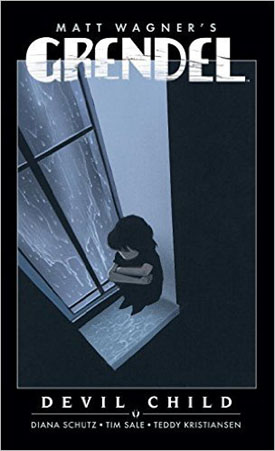 Devil Child, written by Diana Schutz and drawn by Tim Sale, tells the story of Hunter Rose’s adopted child, Stacy Palumbo, and the birth of her daughter, Christine Spar, who became the next Grendel.
Devil Child, written by Diana Schutz and drawn by Tim Sale, tells the story of Hunter Rose’s adopted child, Stacy Palumbo, and the birth of her daughter, Christine Spar, who became the next Grendel.
The story is a narrative by Stacy, told in flashbacks as well as the now, beginning when she is twelve. After the death of Hunter Rose, Stacy is institutionalized in an exclusive facility in upstate New York, under the care of the controversial psychiatrist Dr. Eric Olliver, who eventually marries her, takes her by force on their wedding night, and then hangs himself: after losing Rose, Argent, and now her husband, is it any wonder that Stacy’s troubles revolve around desertion by the men in her life?
This is a story that hovers on the edge of morbidness, with Stacy’s obsessions taking center stage. Christine is a hard-edged but nevertheless refreshing break from the bleakness of Stacy’s existence. However, bleak as the substance of the story is, Schutz has managed to create strong resonance in Stacy’s narration, with the central image of the devil recurring again and again to set up a leitmotiv that expands to include Hunter Rose, Argent, Eric, and even a stray cat that adopts Stacy.
Graphically, the mood is somber: images are spare, colors are muted. Even the reds, which here stand only for blood, are muddy. Characterizations are harsh, in keeping with the narration. I should also note that, in spite of the richness of the modeling in the figures and a tendency toward painterliness in the renderings, Sales maintains a leanness to the images that seems to open up what is otherwise an extraordinarily claustrophobic story.
The blend here is flawless. Schutz and Sales have managed to provide a text in which the elements are mutually supporting with never a sense of strain. (And here I should note that, when looking at graphic works, “text” as part of a critical vocabulary takes on a new meaning that includes both words and images.) Devil Child, while really a sidebar in the Grendel epic (one major point of the story is that Stacy gives Christine the journals that form the basis of Devil by the Deed), sets a very high standard.
By which measure it’s certainly worth reading. It’s not pleasant, but it’s worth it.
(Dark Horse Books, 2008 [orig. Dark Horse Comics, 1999])
